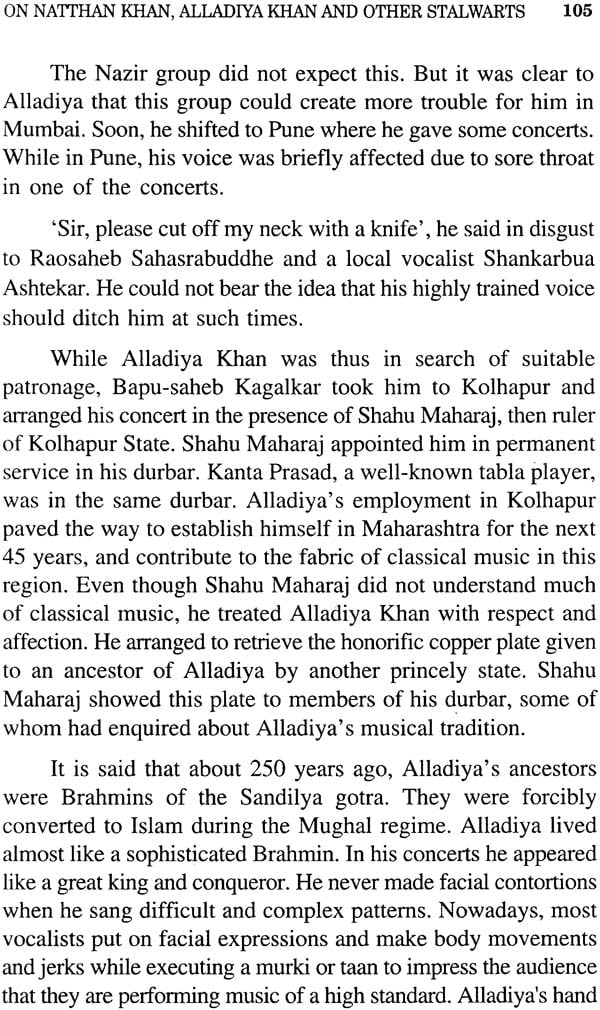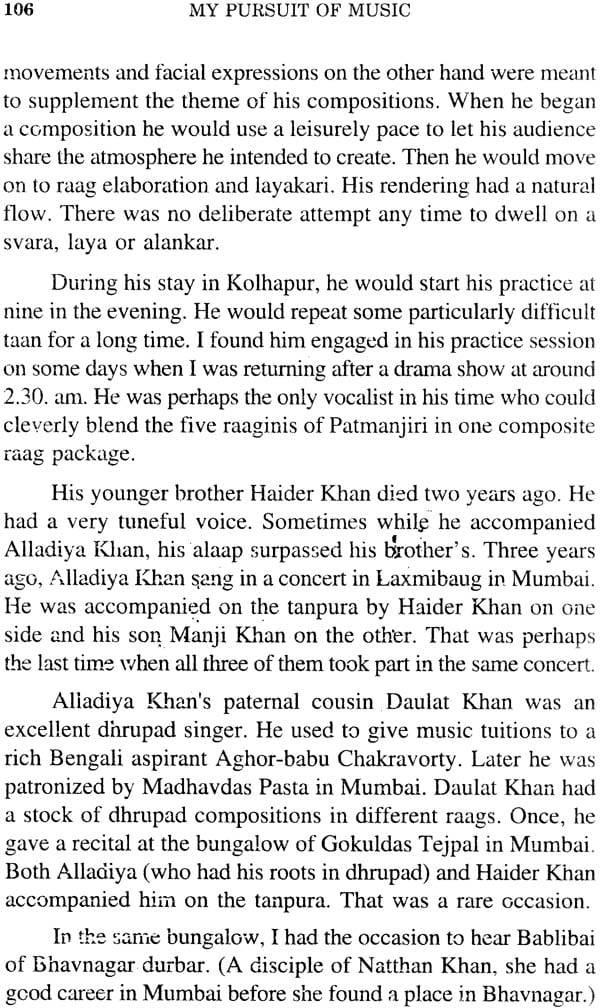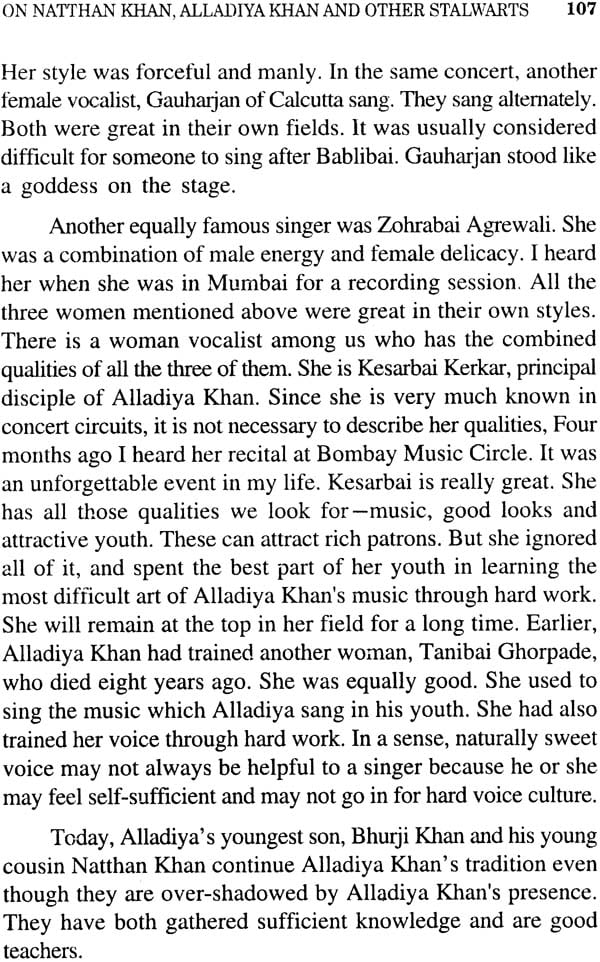
My Pursuit of Music
Book Specification
| Item Code: | NAK044 |
| Author: | Govindrao Tembe |
| Publisher: | Bharatiya Vidya Bhavan |
| Language: | English |
| Edition: | 2014 |
| ISBN: | 9788172765088 |
| Pages: | 200 (16 B/W Illustrations) |
| Cover: | Paperback |
| Other Details | 9.0 inch x 6.0 inch |
| Weight | 190 gm |
Book Description
Govindrao Tembe (1881-1955), born in Kolhapur District, Maharashtra, began as a self-taught harmonium player and became one of its foremost exponents in western India. His fame grew when he was made in-charge of selecting tunes for 'Maanaapamaan' (1911), a landmark Marathi play. This was the first time when Marathi stage music was placed in the hands of a musician. Till then the playwright himself routinely selected the tunes for the different characters of his play.
Trained by eminent Hindustani classical vocalist Bhaskarbua Bakhle, Tembe soon joined Bal Gandharva's drama unit as a singer-actor and music supervisor, and later set-up his own unit which had a success story for some years. His later landmark includes his career in films of the early talkie era.
Tembe wrote plays, operas, songs, many articles on music- related topics, and a few books, including Kalpana Sangeet which discusses his concept of some Hindustani raags of his choice. In his later life he was influenced by the music of vocalist Alladiya Khan.
This book, a translation of Tembe's memoirs in Marathi Maazha Sangeet Vyaasang, gives an account of his quest to learn music which began in his school days in Kolhapur and blossomed well mainly in Mumbai. He belonged to a period when he could often hear great and middle-range male and female artistes of Hindustani classical music such as Balkrishnabua Ichalkaranjikar (guru of Vishnu Digambar Paluskar), Rahimat Khan, Manji Khan, Gauharjan, Bablibai Salgaonkar and Zohrabai Agrewali. He writes on most of them - their all-night house concerts, high points, the audience at these sessions, patrons and related topics. All those bits of music history of old Bombay come alive in this well-narrated book.
Govindrao Tembe's memoirs, in English, is a source of delight to many of us who cannot read its original in Marathi. All those who are associated with the English version are highly grateful to Mr H. N. Dastur, Executive Secretary of Bharatiya Vidya Bhavan, for his enlightened approach of placing this regional work into the English stream for wider exposure.
This translation is from the second edition of Tembe's work, Maaza Sangeet Vyaasang with scholar S.V. Gokhale's annotative notes, published by the Maharashtra State Sahitya and Sanskriti Mandal, Dadar, Mumbai. The late translator's wife, Ms Rohini Kuddyady, received the formal permission, with the kind help of Mr U.S. Lonare and Ms Gauri Deshmukh of the Mandal, for translation of the work into English and getting it published.
Govindrao Tembe was obsessed with the harmonium at a time when many music stalwarts scoffed at its limitations within the fold of Indian classical music. But Tembe went ahead, learnt Hindustani classical music from Bhaskarbua Bakhle, listened to great masters of the harmonium of his time, and used every opportunity to promote the instrument. Eventually he was revered as a wizard of the instrument.
But he was meant for more: he became well-known as a tune-setter, singer-actor, lyric writer and playwright during the peak of the Marathi sangeet natak (musical plays) years. When the talkie era dawned he became part of that too. He gave music and played the title role in the first Marathi talkie, 'Ayodhyache Raja' (1932). Some more films followed.
Tembe showed interest in literary pursuits unlike many artistes of his time. Besides songs, musical plays and two radio operas, he wrote a number of articles and a few more books including a short biography of Alladiya Khan, and a book on his concepts of some Hindustani raags entitled Kalpana Sangeet.
Tembe's memoirs may also be seen as a document of authentic profiles useful for studying the history of classical music in Mumbai during 1900-1930. He has heard many artistes performing (including Balkrishnabua Ichalkaranjikar, guru of Vishnu Digambar Paluskar), met some of them, and observed many more from close angles. We have only heard of the stormy singer-actor Bhaurao Kolhatkar (died, 1901) but Tembe tried not to miss his plays and met him in his last days. He has heard Gwalior's Rahimat Khan, once a sensation, in his sunset days. Tembe says Khan-saheb still had the unusual melodic streak for which he was known.
Other greats in his notes include the harmonium legend Ganpatrao Bhaiyya and thumri king Maujuddin Khan. Most of them presented some of their best concerts in Mumbai. Tembe mentions three classics - a bhajan and two thumris - of Maujuddin from his all-night house concerts which lingered in his memory :
* Ab toh jeevan haare. raakho sharan. heh Govind! ... (bhajan)
* More raja! ... kinvadiyaah kholo ... baarish-ki boond padi
* Bola re ... papee haraa ...
One of Maujuddin's night-long sessions that Tembe attended was at the residence of a charming singer-dancer Baputara (or Tarabapu) in Girgaum, the heart of old Bombay. Her real name was Tarabai Welingkar. Great names, including Bakhle and Barkatullah Khan, were in the audience. Many such all-night sessions were patronized by elites even from far-off metros. For instance, Seth Dulichand of Kolkata camped with his entourage in his Mumbai bungalow on Peddar Road, near Bhavan, for a few months every year. He attended many musical nights and also hosted some night-long concerts in his bungalow. Many such bits of music history come alive in the pages of this book.
Mr Chandrakant Kuddyady made the first draft of this work on the guidelines given by Dr S.D. Pillai. Mr Kuddyady was then assisting Dr Pillai, the Executive Editor of the Encyclopaedia of Music in India project conducted by Sangit Mahabharati, Juhu, Mumbai. Apart from the experience he gained in the encyclopaedia project, Mr Kuddyady had, long before he joined the project, completed a five-year vocal music course from Bharatiya Vidya Bhavan - which is one more reason why Or Pillai thought he would do justice to the work. As Mr Kuddyady passed away in 2005, Ms Rohini Kuddyady requested Dr Pillai to process the Tembe manuscript - in his spare hours - to a publishable level.
A senior sociologist with 12 books to his credit, Dr S. D. Pillai was at Bombay University first as MA and PhD scholar and later as de facto head - designated as Senior Research Officer and Deputy Director successively - of high profile research projects for some years. He had similar research assignments with Indo-Dutch projects of the Amsterdam University. His flair for writing has benefited the quality of the present work.
Ms Shubhada Burde, Ms Archana Mangalore and Mr P. Ravindra keyed in part of the manuscript. Ms Shubhada has also been a pillar of assistance to Ms Kuddyady and Dr Pillai in handling many issues that usually crop up during the preparation of a manuscript.
As a sarangi player myself it is gratifying to recall that Marathi Natya Sangeet, of which Tembe was an icon, was a very strong medium that brought sarangi into prominence in Mumbai and other cities.
| Preface | v | |
| 1 | Early Days, First Lessons | 1 |
| 2 | Participation in a Performance Troupe | 5 |
| 3 | Saw Dramas, met Bhaurao Kolhatkar | 12 |
| 4 | Contacts With Actor Halyalkar and a Harmonium Pioneer | 22 |
| 5 | Got a Pedal Harmonium, saw 'Mookanayak'. | 34 |
| 6 | With Bakhle and Bhatkhande in Mumbai | 42 |
| 7 | Bhaskarbua Bakhle Talks of His Guru | 52 |
| 8 | Long Musical Nights in Mumbai | 63 |
| 9 | Rahimat Khan - Bhu-gandharva | 80 |
| 10 | More Memories of Kolhapur, Abdul Karim Khan and the Shruti Experiments | 88 |
| 11 | On Natthan Khan, Alladiya Khan and Other Stalwarts | 97 |
| 12 | Concluding Notes | 108 |
| 13 | Appendix: Notes by S. V. Gokhale | 113 |
| Index | 142 |













